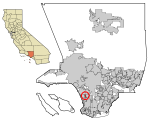Redondo Beach station

Redondo Beach station is an elevated light rail station on the C Line of the Los Angeles Metro Rail system. It is located over Marine Avenue in the city of Redondo Beach, California, after which the station is named. It opened with the commencement of Green Line service on August 12, 1995. The station is currently the western terminus of the C Line. By 2024, Redondo Beach station will be served by the K Line after it gets extended there and the C Line gets rerouted to LAX Airport at the future LAX/Metro Transit Center station. The original name for the station was Marine Ave / Redondo Beach Ave, until 2005 when the station was renamed Redondo Beach. An extension beyond Redondo Beach into Torrance is in the planning stages. The train platform, currently suitable for two-car trains, is planned to be lengthened by 2028 to accommodate three-car trains to enable increased capacity of the line.
Excerpt from the Wikipedia article Redondo Beach station (License: CC BY-SA 3.0, Authors, Images).Redondo Beach station
Marine Avenue,
Geographical coordinates (GPS) Address Nearby Places Show on map
Geographical coordinates (GPS)
| Latitude | Longitude |
|---|---|
| N 33.8947 ° | E -118.3693 ° |
Address
Marine Avenue
Marine Avenue
90260
California, United States
Open on Google Maps






